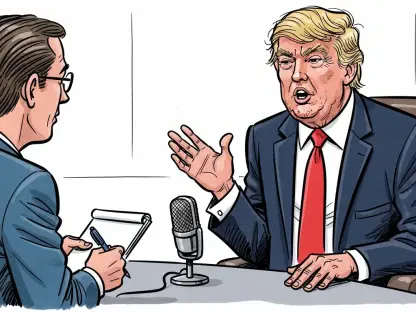With global economies entwined through intricate trade networks, the US-China trade relationship stands out as one of the most crucial. Recent discussions held in the prestigious setting of the Swiss ambassador’s villa in Geneva signal a shift toward easing the significant trade tensions initiated under the former US administration. This article presents insights from industry experts, economists, and trade analysts on how these talks mark a notable milestone in restoring economic stability between the two largest global economies.
Historical Context and Importance
The trade tensions began with the aggressive imposition of tariffs under the Trump administration, which shook the economic landscapes of both countries. This backdrop serves as a crucial turning point, highlighting why resolving the impasse is so significant. The imposition of tariffs set the stage for retaliatory measures from China, resulting in a prolonged period of economic strain. Consequently, current negotiations represent a vital step toward mending fractured trade relations.
Resolving this tariff standoff holds immense significance for both countries and the global economy. Economists highlight the potential for increased trade flow, leading to mutual economic growth, stability of global markets, and reduction in international prices. Furthermore, experts agree that such resolutions contribute to an improved environment for international business operations, paving the way for potential investments and collaborations.
The expected developments from this diplomatic encounter underscore the potential long-term implications of eased tariffs. Analysts and observers anticipate an unfolding reduction in tariffs could positively affect global economic dynamics, enhancing trade efficiency between major economies. While immediate resolutions are unlikely, this initial meeting sets the stage for continuous dialogue and policy adjustments.
Perspectives from Recent Developments
Face-to-Face Dialogues as a Milestone
The Geneva talks marked a historic moment as senior officials from the US and China met for the first time since the enforcement of tariffs. This face-to-face interaction is being hailed as a crucial step in initiating dialogue that could lead to substantial progress in trade relationships. Industry observers note the positive sentiments expressed by both US Treasury Secretary Scott Bessent and Chinese Vice Premier He Lifeng, indicating a mutual acknowledgment of advancements.
Economic Impact of Tariffs
Data analysis reveals significant economic consequences stemming from prolonged tariffs. Economists point to increased consumer prices and disrupted supply chains as two of the more detrimental effects on both economies. Several reports indicate that these tariffs have not only strained economic relations but also encumbered businesses reliant on international trade.
Contrasting Views on the Outcomes
Perspectives regarding these developments range from skeptical to optimistic. While some trade experts express cautious optimism, believing the discussions establish a more amiable trade environment, others remain skeptical about the depth of this progress. Analysts underscore the potential limitations and note that substantial changes to the trade dynamics may take time.
In-Depth Analysis
Tariff Easing Strategies
Analysis reveals that the ongoing discussions focus significantly on strategies to ease tariffs. A proposed 80% reduction in tariffs, initially advocated by the Trump administration, finds support among moderate US officials and economic strategists. However, this potential easing is viewed as dependent on mutual concessions from both sides.
Global Market Impacts
The impact on global markets from potential tariff reductions is anticipated to be significant. Financial experts suggest that clearer, more predictable trade relationship conditions could lead to positive market responses. Additionally, businesses reliant on these trade networks might experience improvements in their operational environments.
Risks and Competitive Dynamics
As these discussions unfold, potential risks and competitive dynamics between the US and China remain high. While easing trade tensions may open new opportunities, experts caution that competitiveness issues persist. Identifying ways to navigate these challenges remains a priority in benefiting from eased tensions.
Exploring Trade Negotiations
Complexities Beyond Surface-Level Understandings
Trade negotiations extend beyond mere discussions of tariffs and policies. The intricacies of these talks involve broader strategic considerations, including intellectual property, market access, and regulatory standards. Analysts emphasize the need for both parties to assess underlying complexities to achieve lasting resolutions.
Global Reactions
Various global economies are closely observing these discussions, with some nations recalibrating their trade policies in response. The potential for shifts in global trade norms is evident, indicating this bilateral discussion’s widespread implications.
Emerging Trends in Trade Norms
The unfolding of these talks signals an evolving landscape for international trade norms. Industry leaders recognize the importance of embracing emerging trends such as digital trade agreements, which may redefine aspects of global commerce. This acknowledgment positions nations to adapt to the changing trade paradigm.
Comparative Analysis with Other Trade Dialogues
US-UK Versus US-China Dialogue
Exploring the differences between the US-UK trade approaches and the US-China dialogue reveals varying strategic imperatives. The US-UK agreement maintains a 10% baseline tariff, revealing distinct priorities in trade policy. Experts advocate for a more tailored approach acknowledging the unique dynamics of each trade relationship.
Expert Opinions on Strategic Moves
Insights from trade analysts highlight the long-term strategic moves associated with ongoing negotiations. While optimistic outcomes are predicted, experts warn policymakers to consider potential adjustments that may be necessary as negotiations evolve. Recognizing the need for strategic flexibility is crucial in these discussions.
Future Directions for Global Trade
The future of global trade relations remains a subject of intense speculation. Imaginative reflections suggest potential shifts toward more sustainable practices and digital innovations. These evolutions highlight the importance of adapting to modern trade demands while balancing traditional principles.
Next Steps for Stakeholders
Lessons and Recommendations
Lessons from recent US-China talks highlight the importance of mutual cooperation and patience. Aligning stakeholder interests remains crucial in achieving successful long-term agreements. Industry leaders stress the value of remaining informed about ongoing developments and adapting strategies accordingly.
Leveraging Eased Tensions
Businesses and policymakers can benefit from the easing of trade tensions by seizing new opportunities for expansion and collaboration. Enhancing market awareness and flexibility can foster robust international relations. Ensuring readiness for potential policy shifts will enable stakeholders to capitalize on favorable trade conditions.
Reflecting on Progress and Future Considerations
Reflecting on the progress and challenges in US-China trade relations highlights an evolving landscape. The continued relevance of this economic relationship underscores its potential impact on the global stage. As talks progress, understanding the intricacies of international trade dynamics will remain critical for all parties involved. Stakeholders must be prepared for evolving scenarios, ensuring readiness to adapt to the potentially significant shifts expected in international trade patterns.









